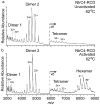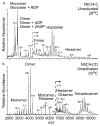Receiver domains control the active-state stoichiometry of Aquifex aeolicus sigma54 activator NtrC4, as revealed by electrospray ionization mass spectrometry
- PMID: 19699748
- PMCID: PMC2763505
- DOI: 10.1016/j.jmb.2009.08.033
Receiver domains control the active-state stoichiometry of Aquifex aeolicus sigma54 activator NtrC4, as revealed by electrospray ionization mass spectrometry
Abstract
A common challenge with studies of proteins in vitro is determining which constructs and conditions are most physiologically relevant. sigma(54) activators are proteins that undergo regulated assembly to form an active ATPase ring that enables transcription by sigma(54)-polymerase. Previous studies of AAA(+) ATPase domains from sigma(54) activators have shown that some are heptamers, while others are hexamers. Because active oligomers assemble from off-state dimers, it was thought that even-numbered oligomers should dominate, and that heptamer formation would occur when individual domains of the activators, rather than the intact proteins, were studied. Here we present results from electrospray ionization mass spectrometry experiments characterizing the assembly states of intact NtrC4 (a sigma(54) activator from Aquifex aeolicus, an extreme thermophile), as well as its ATPase domain alone, and regulatory-ATPase and ATPase-DNA binding domain combinations. We show that the full-length and activated regulatory-ATPase proteins form hexamers, whereas the isolated ATPase domain, unactivated regulatory-ATPase, and ATPase-DNA binding domain form heptamers. Activation of the N-terminal regulatory domain is the key factor stabilizing the hexamer form of the ATPase, relative to the heptamer.
Figures





Similar articles
-
Structural mechanism of GAF-regulated σ(54) activators from Aquifex aeolicus.J Mol Biol. 2013 Jan 9;425(1):156-70. doi: 10.1016/j.jmb.2012.10.017. Epub 2012 Nov 1. J Mol Biol. 2013. PMID: 23123379 Free PMC article.
-
Crystallization and preliminary X-ray analysis of the ATPase domain of the σ(54)-dependent transcription activator NtrC1 from Aquifex aeolicus bound to the ATP analog ADP-BeFx.Acta Crystallogr Sect F Struct Biol Cryst Commun. 2013 Dec;69(Pt 12):1384-8. doi: 10.1107/S174430911302976X. Epub 2013 Nov 29. Acta Crystallogr Sect F Struct Biol Cryst Commun. 2013. PMID: 24316836 Free PMC article.
-
Structure, function, and tethering of DNA-binding domains in σ⁵⁴ transcriptional activators.Biopolymers. 2013 Dec;99(12):1082-96. doi: 10.1002/bip.22333. Biopolymers. 2013. PMID: 23818155 Free PMC article.
-
Bacterial Enhancer Binding Proteins-AAA+ Proteins in Transcription Activation.Biomolecules. 2020 Feb 25;10(3):351. doi: 10.3390/biom10030351. Biomolecules. 2020. PMID: 32106553 Free PMC article. Review.
-
The bacterial enhancer-dependent RNA polymerase.Biochem J. 2016 Nov 1;473(21):3741-3753. doi: 10.1042/BCJ20160741C. Biochem J. 2016. PMID: 27789741 Free PMC article. Review.
Cited by
-
Hexameric assembly of the AAA+ protein McrB is necessary for GTPase activity.Nucleic Acids Res. 2019 Jan 25;47(2):868-882. doi: 10.1093/nar/gky1170. Nucleic Acids Res. 2019. PMID: 30521042 Free PMC article.
-
Nucleotide-induced asymmetry within ATPase activator ring drives σ54-RNAP interaction and ATP hydrolysis.Genes Dev. 2013 Nov 15;27(22):2500-11. doi: 10.1101/gad.229385.113. Genes Dev. 2013. PMID: 24240239 Free PMC article.
-
Molecular Mechanisms of Two-Component Signal Transduction.J Mol Biol. 2016 Sep 25;428(19):3752-75. doi: 10.1016/j.jmb.2016.08.003. Epub 2016 Aug 9. J Mol Biol. 2016. PMID: 27519796 Free PMC article. Review.
-
Unique ATPase site architecture triggers cis-mediated synchronized ATP binding in heptameric AAA+-ATPase domain of flagellar regulatory protein FlrC.J Biol Chem. 2015 Apr 3;290(14):8734-47. doi: 10.1074/jbc.M114.611434. Epub 2015 Feb 16. J Biol Chem. 2015. PMID: 25688103 Free PMC article.
-
Diversity of structure and function of response regulator output domains.Curr Opin Microbiol. 2010 Apr;13(2):150-9. doi: 10.1016/j.mib.2010.01.005. Epub 2010 Mar 11. Curr Opin Microbiol. 2010. PMID: 20226724 Free PMC article. Review.
References
Publication types
MeSH terms
Substances
Grants and funding
LinkOut - more resources
Full Text Sources

